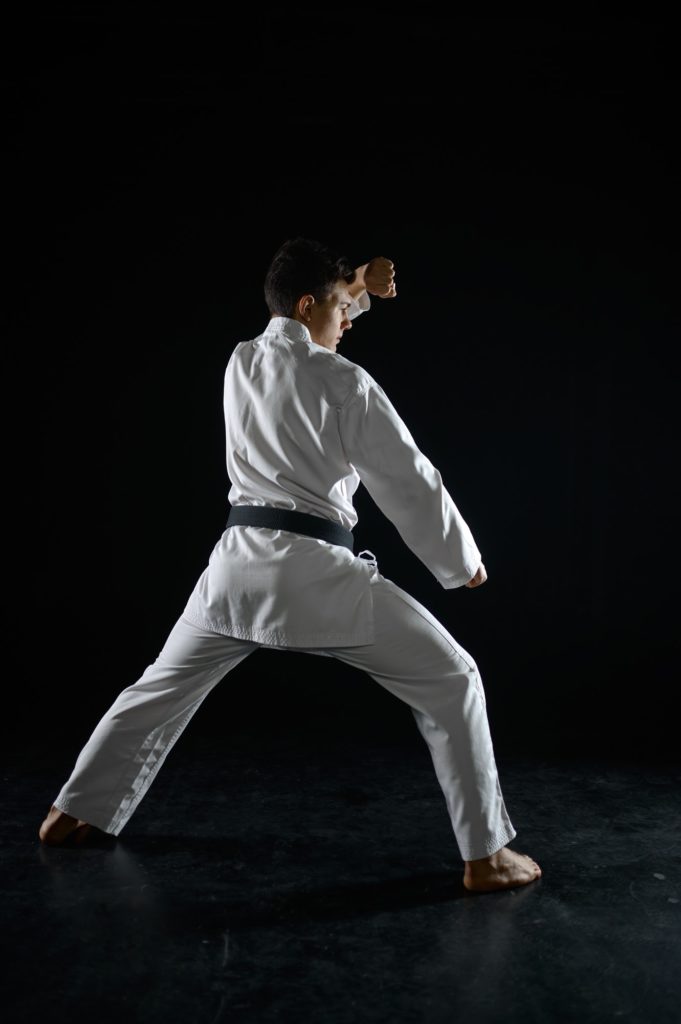In karate, stances, or “Dachi” in Japanese, are essential. They are the basis of movements and techniques, providing the balance and stability needed to execute punches, kicks and blocks correctly. Here are some of the most common and important positions in karate.
1. Zenkutsu-Dachi (Front position)
This is one of the most commonly used positions in karate. In this position, the front foot is pointed forward, while the rear foot is turned outwards by about 30 degrees. Body weight is distributed 70% on the front leg and 30% on the rear leg, giving this position great frontal stability.
2. Kokutsu-Dachi (Rear position)
The rear position is essentially the opposite of the front position. The rear foot is pointed forward and the front foot is turned outwards by about 30 degrees. Most of the body weight is on the rear leg, with a distribution of around 70% to the rear and 30% to the front. This position is often used for blocking techniques.
3. Kiba-Dachi (Knight position)
The rider position is a stable position with feet about twice shoulder-width apart. The feet are parallel and point forward, and the body weight is distributed evenly on both legs. This position is often used for techniques requiring high lateral stability.
4. Neko-Ashi-Dachi (Cat stance)
In the cat position, the body weight is mainly on the back leg, while the front leg is slightly bent with the foot touching the ground with the toes. This position is often used for fast, agile movements, hence its name.
5. Sanchin-Dachi (Happy stance)
The happy position is a narrow, stable stance, with feet in a straight line and knees slightly bent. The weight of the body is distributed equally on both legs. This position is often used in katas, particularly in the Goju-Ryu style.
6. Shiko-Dachi (Sumo stance)
The sumo position is a wide, stable stance, with the feet pointing outwards at about 45 degrees. The knees are bent and the body weight is distributed evenly over both legs. This position is often used for techniques requiring great stability and a wide base.
These positions, though apparently simple, require constant practice and mastery to be performed correctly. Each of these positions has its own advantages and is used for different techniques and movements. Mastering them all gives the karateka greater versatility and a better understanding of the principles of karate.
7. Hanmi-Dachi (Semi-Face position)
In Hanmi-Dachi position, the body is positioned semi-laterally, with the front foot pointing forward and the rear foot perpendicular to it. This position is often used in combat, providing a solid guard while offering a reduced target to the opponent.
8. Heisoku-Dachi (Closed Feet Position)
The Heisoku-Dachi position is a resting position where the feet are together and parallel, heels and toes touching. This position is usually adopted during greetings at the beginning and end of the course.
9. Musubi-Dachi (Crossed Feet Position)
Similar to Heisoku-Dachi, Musubi-Dachi is also a resting position, but with the heels apart and the toes pointing slightly outwards, forming a V.
10. Fudo-Dachi (Immovable position)
Fudo-Dachi, also known as Sochin-Dachi, is a sturdy position that offers great stability. The weight of the body is distributed equally between the two legs, with the front foot pointing forward and the rear foot turned at about 30 degrees.
In short, understanding and mastering these different positions is crucial to the karateka’s development. They not only provide a foundation for techniques, but also help develop strength, balance, stability and body awareness. It is essential to remember that the quality of the position directly influences the quality of the technique. Consequently, a constant effort must be made to improve and perfect these basic positions.
As you progress in your karate practice, you’ll discover that these positions are much more than just a way of standing or moving. They are in fact expressions of karate itself, reflecting the principles of stability, fluidity and control that lie at the heart of this martial art.


